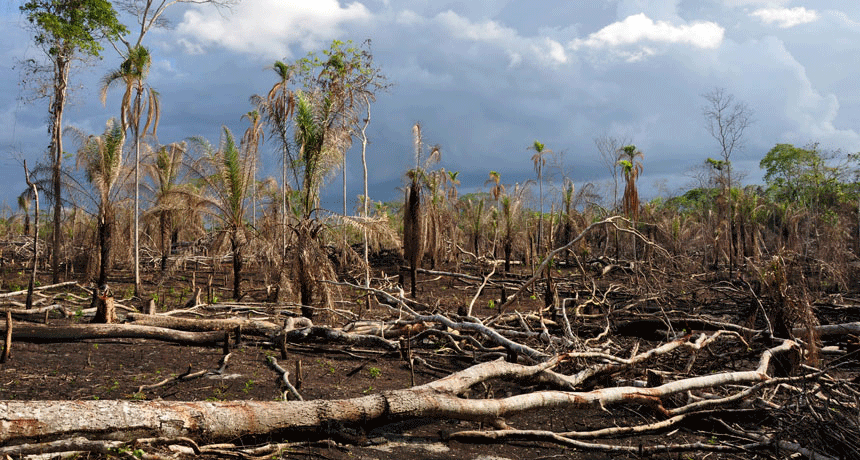Tropics may now emit more carbon dioxide than they absorb
The assessment suggests that damage to forests can dramatically change how much carbon they can store

Severely degraded forests, such as this one in Bolivia, are helping convert the tropics — sometimes called the “lungs of the planet” — into carbon emitters.
Wayne Walker
The world’s tropical forests are exhaling — and it’s not a sigh of relief.
Forests are sometimes called the “lungs of the planet.” That’s because trees and other plants take in carbon dioxide gas and release oxygen. Past analyses had estimated that forests soak up more carbon dioxide than they release. Because carbon dioxide is a climate-warming greenhouse gas, that trend was encouraging. But new data suggest the trend no longer holds.
Trees and other plants use the carbon in that carbon dioxide as an ingredient in all of their cells. A study now suggests that tropical forests today return more carbon back into the atmosphere than they remove from it as carbon dioxide (CO2). As plant matter (including leaves, tree trunks and roots) break down — or rot — their carbon will be recycled back into the environment. Much of it will enter the atmosphere as CO2.
Deforestation refers to the cutting down of forests to open up room for such things as farms, roads and cities. Fewer trees mean there are fewer leaves available to take up CO2.
But far more of the forests’ release of CO2 — more than two-thirds of it — comes from a less visible source: a drop in the number and types of trees that remain in tropical forests. Even in seemingly intact forests, the health of trees — and their uptake of CO2 — can be diminished or disturbed. Selectively removing certain trees, environmental change, wildfires, disease — all can all take a toll.
For the new study, scientists analyzed satellite images of tropical Asia, Africa and the Americas. Deforestation is easy to see in these images. Areas may look brown, for example, instead of green. Other types of damage can be harder to spot, notes Alessandro Baccini. He is a forest ecologist at the Woods Hole Research Center in Falmouth, Mass. He specializes in remote sensing. That’s the use of satellites to collect information about Earth. To a satellite, Baccini explains, a degraded forest still looks like forest. But it’s less dense. There will be less plant matter and, therefore, less carbon.
“Carbon density is a weight,” Baccini says. “The problem is that there is no satellite in space that can give an estimate of [a forest’s] weight.”
Seeing the forest and the trees
To get around that problem, Baccini and his colleagues came up with a new approach. To estimate the carbon content of the tropics from satellite images, they compared such images to what they could observe for the same sites, but from the ground. They also used a mapping technique called lidar (LY-dahr). They divided each lidar image into square sections. Then, a computer program compared each section of each image to the same section in images taken each year from 2003 to 2014. In this way, they taught the computer program to calculate year-to-year gains — or losses — in carbon density for each section.
Using this approach, the researchers calculated the weight of carbon entering and leaving the forests from year to year.
It now appears that tropical forests have been emitting 862 teragrams of carbon to the atmosphere annually. (A teragram is one quadrillion grams, or 2.2 billion pounds.) That’s more than the carbon released (in the form of CO2) from all the cars in the United States in 2015! At the same time, those forests absorbed 437 teragrams (961 billion pounds) of carbon each year. So the release outweighed the absorption by 425 teragrams (939 billion pounds) of carbon each year. Of that total, almost 7 in every 10 teragrams came from degraded forests. The rest was from deforestation.
Some six in every 10 teragrams of those carbon emissions came from tropical America, including the Amazon Basin. Africa’s tropical forests were responsible for about one-fourth of the global release. The rest came from Asia’s forests.
The researchers shared their findings October 13 in Science.
These findings highlight what changes could give climate and forest experts the biggest benefits, says Wayne Walker. He’s one of the authors. A forest ecologist, he also is a remote sensing specialist at the Woods Hole Research Center. “Forests are low-hanging fruit,” he says. By that he means that keeping forests intact — or rebuilding them where they might have been lost — “is relatively straightforward and inexpensive” as a way to prevent the release of too much climate-warming CO2.
Nancy Harris manages research for the forest program of the World Resources Institute in Washington, D.C. “We’ve known for a long time that forest degradation is happening,” she notes. Until now, however, scientists “haven’t had a good way to measure it.” She says that “this paper goes a long way to capturing it.”
Joshua Fisher points out there may be more to the story, however. Fisher works at NASA’s Jet Propulsion Laboratory in Pasadena, Calif. There, he is a terrestrial ecosystem scientist. That is someone who studies how living organisms and Earth’s physical environment interact. Fisher says that measurements of atmospheric releases of CO2 from tropical forests don’t agree with the new calculations.
Forests are still taking up more carbon than they emit, the atmospheric data show. He says one reason might be dirt. Like plants, soil itself can absorb a large amount of carbon. The new study focuses only on the trees and other things above ground. It doesn’t account for what the soils have absorbed and now hold in storage.
Still, Fisher says, the study shows how important it is to include forest degradation as well as deforestation in studies of climate change. “It’s a good first step ,” he concludes.







